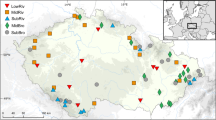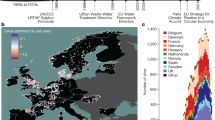Abstract
Freshwater biodiversity is under threat across the globe1, with climate change being a significant contributor2,3. One impact of climate change is the rapid shrinking of glaciers4, resulting in a reduction in glacial meltwater contribution to river flow in many glacierized catchments5,6. These changes potentially affect the biodiversity of specialized glacier-fed river communities7. Perhaps surprisingly then, although freshwater biodiversity is a major conservation priority3, the effects of shrinkage and disappearance of glaciers on river biodiversity have hitherto been poorly quantified. Here we focus on macroinvertebrates (mainly insect larvae) and demonstrate that local (α) and regional (γ) diversity, as well as turnover among reaches (β-diversity), will be consistently reduced by the shrinkage of glaciers. We show that 11–38% of the regional species pools, including endemics, can be expected to be lost following complete disappearance of glaciers in a catchment, and steady shrinkage is likely to reduce taxon turnover in proglacial river systems and local richness at downstream reaches where glacial cover in the catchment is less than 5–30%. Our analysis demonstrates not only the vulnerability of local biodiversity hotspots but also that extinction will probably greatly exceed the few known endemic species in glacier-fed rivers.
This is a preview of subscription content, access via your institution
Access options
Subscribe to this journal
Receive 12 print issues and online access
$209.00 per year
only $17.42 per issue
Buy this article
- Purchase on Springer Link
- Instant access to full article PDF
Prices may be subject to local taxes which are calculated during checkout




Similar content being viewed by others
References
Vörösmarty, C. J. et al. Global threats to human water security and river biodiversity. Nature 467, 555–561 (2010).
Woodward, G., Perkins, D. M. & Brown, L. E. Climate change and freshwater ecosystems: Impacts across multiple levels of organization. Phil. Trans. R. Soc. B 365, 2093–2106 (2010).
Dudgeon, D. et al. Freshwater biodiversity: Importance, threats, status and conservation challenges. Biol. Rev. 81, 163–182 (2006).
Oerlemans, J. Extracting a climate signal from 169 glacier records. Science 308, 675–677 (2005).
Barnett, T. P., Adam, J. C. & Lettenmaier, D. P. Potential impacts of a warming climate on water availability in snow-dominated regions. Nature 438, 303–309 (2005).
Milner, A. M., Brown, L. E. & Hannah, D. H. Hydroecological response of river systems to shrinking glaciers. Hydrol. Process. 23, 62–77 (2009).
Brown, L. E., Hannah, D. M. & Milner, A. M. Vulnerability of alpine stream biodiversity to shrinking glaciers and snowpacks. Glob. Change Biol. 13, 958–966 (2007).
Milner, A. M., Brittain, J. E., Castella, E. & Petts, G. Trends of macroinvertebrate community structure in glacier-fed rivers in relation to environmental conditions: A synthesis. Freshwater Biol. 46, 1833–1847 (2001).
Jacobsen, D. et al. Longitudinal zonation of macroinvertebrates in an Ecuadorian glacier-fed stream: Do tropical glacial systems fit the model? Freshwater Biol. 55, 1234–1248 (2010).
Dawson, T. P., Jackson, S. T. & House, J. I. et al. Beyond predictions: Biodiversity conservation in a changing climate. Science 332, 53–58 (2011).
Burgherr, P. & Ward, J. V. Longitudinal and seasonal distribution patterns of the benthic fauna of an alpine glacial stream (Val Roseg, Swiss Alps). Freshwater Biol. 46, 1705–1721 (2001).
Maiolini, B. & Lencioni, V. Longitudinal distribution of macroinvertebrate assemblages in a glacially influenced stream system in the Italian Alps. Freshwater Biol. 46, 1625–1639 (2001).
Lods-Crozet, B. et al. Macroinvertebrate community structure in relation to environmental variables in a Swiss glacial stream. Freshwater Biol. 46, 1641–1661 (2001).
Hieber, M., Robinson, C. T., Uehlinger, U. & Ward, J. V. A comparison of benthic macroinvertebrate assemblages among different types of alpine streams. Freshwater Biol. 50, 2087–2100 (2005).
Milner, A. M., Robertson, A. L., Monaghan, K. A., Veal, A. J. & Flory, E. A. Colonization and development of an Alaskan stream community over 28 years. Front. Ecol. Environ. 6, 413–419 (2008).
Brown, L. E., Céréghino, R. & Compin, A. Endemic freshwater invertebrates from southern France: Diversity, distribution and conservation implications. Biol. Conserv. 142, 2613–2619 (2009).
Stagliano, D. M., Stephens, G. M. & Bosworth, W. R. Aquatic Invertebrate Species of Concern on USFS Northern Region Lands (USDA Forest Service, 2007).
Bálint, M. et al. Cryptic biodiversity loss linked to global climate change. Nature Clim. Change 1, 313–318 (2011).
Chase, J. M. Drought mediates the importance of stochastic community assembly. Proc. Natl Acad. Sci. USA 104, 17430–17434 (2007).
Jacobsen, D. & Dangles, O. Environmental harshness and global richness patterns in glacier-fed streams. Glob. Ecol. Biogeogr. http://dx.doi.org/1466-8238.2011.00699.x (2011).
Heino, J. & Soininen, J. Are higher taxa adequate surrogates for species-level assemblage patterns and species richness in stream organisms? Biol. Conserv. 137, 78–89 (2007).
Füreder, L. et al. Reference conditions of Alpine streams: Physical habitat and ecology. Water Air Soil Pollution 2, 275–294 (2002).
Jacobsen, D. Low oxygen pressure as a driving factor for the altitudinal decline in taxon richness of stream macroinvertebrates. Oecologia 154, 795–807 (2008).
Connell, J. H. Diversity in tropical rain forests and coral reefs. Science 199, 1302–1310 (1978).
Inman, M. Settling the science on Himalayan glaciers. Nature Rep. Clim. Change 4, 28–30 (2010).
Finn, D. S., Räsänen, K. & Robinson, C. T. Physical and biological changes to a lengthening stream gradient following a decade of rapid glacial recession. Global Change Biol. 16, 3314–3326 (2010).
Wallace, J. B. & Webster, J. R. The role of macroinvertebrates in stream ecosystem function. Ann. Rev. Entomol. 41, 115–139 (1996).
Dangles, O. et al. Predicting diversity effects on ecosystem function in natural communities: Insights from extreme stream ecosystems. Ecology 92, 733–743 (2011).
Füreder, L., Schütz, C., Wallinger, M. & Burger, R. Physico-chemistry and aquatic insects of a glacier-fed and a spring-fed alpine stream. Freshwater Biol. 46, 1673–1690 (2001).
Acknowledgements
We thank M. O. Gessner, K. Swing and J. Casas for constructive and helpful comments on earlier versions of the paper. The financial support by WWF-Novozymes (2008) to D.J., Ecofondo (034-ECO8-inv1) to O.D., Natural Environment Research Council (GR9/2913, NE/E003729/1, NE/E004539/1 and NE/E004148/1), the Royal Society, the Institut de Recherche pour le Développement (IRD), and the Universities of Copenhagen, Birmingham and Leeds is greatly appreciated. Many people participated in the fieldwork and collection of data for the published papers analysed and cited here; we acknowledge the effort of these people and wish to thank them all.
Author information
Authors and Affiliations
Contributions
D.J. and O.D. collected the Ecuadorian data, conceived the study, analysed the data and led the writing of the paper. A.M.M. and L.E.B. collected the Alaska data and contributed to the writing of the manuscript. D.J. and O.D. contributed equally to the study.
Corresponding authors
Ethics declarations
Competing interests
The authors declare no competing financial interests.
Supplementary information
Rights and permissions
About this article
Cite this article
Jacobsen, D., Milner, A., Brown, L. et al. Biodiversity under threat in glacier-fed river systems. Nature Clim Change 2, 361–364 (2012). https://doi.org/10.1038/nclimate1435
Received:
Accepted:
Published:
Issue Date:
DOI: https://doi.org/10.1038/nclimate1435
This article is cited by
-
Trajectories of freshwater microbial genomics and greenhouse gas saturation upon glacial retreat
Nature Communications (2023)
-
Glacier retreat reorganizes river habitats leaving refugia for Alpine invertebrate biodiversity poorly protected
Nature Ecology & Evolution (2023)
-
Uncovering aquatic diversity patterns in two Patagonian glacial lakes: does habitat heterogeneity matter?
Aquatic Sciences (2023)
-
Implications of changing cropping pattern to low water demand plants due to climate change: evidence from Iran
Environment, Development and Sustainability (2022)
-
Modelling land system evolution and dynamics of terrestrial carbon stocks in the Luanhe River Basin, China: a scenario analysis of trade-offs and synergies between sustainable development goals
Sustainability Science (2022)



